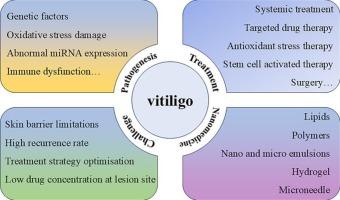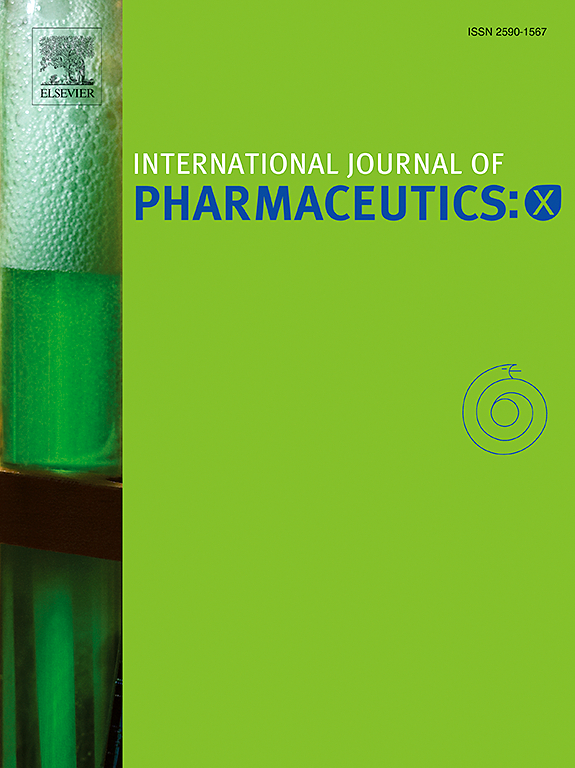白癜风发病机制的研究进展及新型给药系统在其治疗中的应用
IF 6.4
2区 医学
Q1 PHARMACOLOGY & PHARMACY
引用次数: 0
摘要
白癜风是一种获得性脱色性皮肤疾病,严重影响患者的身心健康,主要表现为表皮黑色素细胞的丧失,导致皮肤和粘膜出现白色斑块。白癜风的发病机制复杂,氧化应激、免疫失衡等因素的相互作用起着关键作用。目前的治疗策略主要集中在减轻氧化应激来调节免疫反应,从而抑制损害黑素细胞的过度免疫激活,药物干预是主要方法。然而,由于皮肤角质层的屏障作用,这些治疗方法的治疗效果仍然不理想。新型纳米粒子给药系统的引入彻底改变了白癜风的局部治疗,提高了药物的有效性和安全性,并为个性化和精确治疗提供了新的可能性。在这篇综述中,我们系统地总结了白癜风发病机制、治疗策略和纳米颗粒治疗的最新进展,重点介绍了基于脂质和聚合物的纳米颗粒给药系统、纳米乳液、微乳液、水凝胶和微针。这些研究强调通过提高白癜风的载药效率、提高皮肤穿透性和增加局部药物浓度来改善白癜风的治疗效果,为进一步研究白癜风的发病机制和开发新的治疗药物提供理论支持。本文章由计算机程序翻译,如有差异,请以英文原文为准。

recent advances in the pathogenesis of vitiligo and the application of novel drug delivery systems in its treatment
Vitiligo is an acquired depigmenting skin disorder that significantly impacts the physical and mental health of patients, primarily characterized by the loss of epidermal melanocytes, leading to white patches on the skin and mucous membranes. The pathogenesis of vitiligo is complex, with oxidative stress, immune imbalance, and the interaction between these two factors playing a key role. Current treatment strategies mainly focus on alleviating oxidative stress to regulate immune responses, thereby inhibiting the excessive immune activation that damages melanocytes, with drug interventions being the primary approach. However, due to the barrier effect of the skin's stratum corneum, the therapeutic outcomes of these treatments remain suboptimal. The introduction of novel nanoparticle drug delivery systems has revolutionized local treatments for vitiligo, enhancing both the efficacy and safety of drugs and offering new possibilities for personalized and precision treatments. In this review, we systematically summarize the latest advances in the understanding of vitiligo's pathogenesis, treatment strategies, and the role of nanoparticle-based therapies, with a focus on lipid-based and polymeric nanoparticle drug delivery systems, nanoemulsions, microemulsions, hydrogels, and microneedles. These studies emphasize improving treatment outcomes for vitiligo by enhancing drug loading efficiency, improving skin penetration, and increasing local drug concentration, providing theoretical support for further research into vitiligo's pathogenesis and the development of novel therapeutic agents.
求助全文
通过发布文献求助,成功后即可免费获取论文全文。
去求助
来源期刊

International Journal of Pharmaceutics: X
Pharmacology, Toxicology and Pharmaceutics-Pharmaceutical Science
CiteScore
6.60
自引率
0.00%
发文量
32
审稿时长
24 days
期刊介绍:
International Journal of Pharmaceutics: X offers authors with high-quality research who want to publish in a gold open access journal the opportunity to make their work immediately, permanently, and freely accessible.
International Journal of Pharmaceutics: X authors will pay an article publishing charge (APC), have a choice of license options, and retain copyright. Please check the APC here. The journal is indexed in SCOPUS, PUBMED, PMC and DOAJ.
The International Journal of Pharmaceutics is the second most cited journal in the "Pharmacy & Pharmacology" category out of 358 journals, being the true home for pharmaceutical scientists concerned with the physical, chemical and biological properties of devices and delivery systems for drugs, vaccines and biologicals, including their design, manufacture and evaluation. This includes evaluation of the properties of drugs, excipients such as surfactants and polymers and novel materials. The journal has special sections on pharmaceutical nanotechnology and personalized medicines, and publishes research papers, reviews, commentaries and letters to the editor as well as special issues.
 求助内容:
求助内容: 应助结果提醒方式:
应助结果提醒方式:


